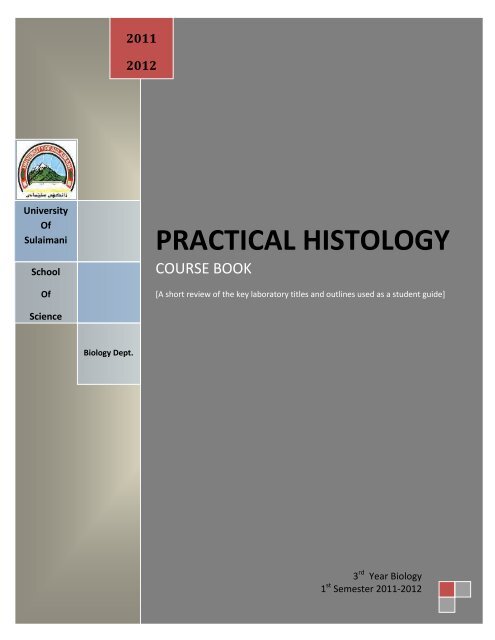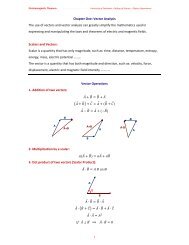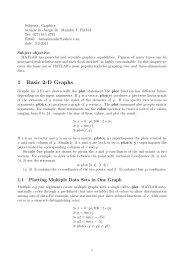Course Book - University of Sulaimani
Course Book - University of Sulaimani
Course Book - University of Sulaimani
You also want an ePaper? Increase the reach of your titles
YUMPU automatically turns print PDFs into web optimized ePapers that Google loves.
2011<br />
2012<br />
<strong>University</strong><br />
Of<br />
<strong>Sulaimani</strong><br />
School<br />
Of<br />
PRACTICAL HISTOLOGY<br />
COURSE BOOK<br />
[A short review <strong>of</strong> the key laboratory titles and outlines used as a student guide]<br />
Science<br />
Biology Dept.<br />
3 rd Year Biology<br />
1 st Semester 2011-2012
Practical Histology <strong>Course</strong> <strong>Book</strong> .UOS 2011 1
<strong>Course</strong> title<br />
Histology<br />
lecturers in charge Assist. lecturer: Sirwan Mustafa Mohammed<br />
Assist. lecturer: Shilan Muhammad Ra'uf<br />
Dept/ College Biology Science<br />
Contact details Email: sirwan.mohammed@univsul.net<br />
shilan.rauf@univsul.net<br />
Lecturer’s Code 41211337<br />
Coordinator’s<br />
name<br />
Sirwan M. Mohammed<br />
sirwan75@gmail.com<br />
<strong>Course</strong> overview:<br />
Histology is the study <strong>of</strong> microscopic anatomy dealing with the structures <strong>of</strong> cells,<br />
tissue and organs in relation to their functions.<br />
The first part <strong>of</strong> the course deals with basic tissues (a collection <strong>of</strong> similar cells and<br />
the extracellular matrices surrounding them): epithelium; connective tissues<br />
(proper, specialized- blood, bone and cartilage); muscles; and nerves.<br />
The second part <strong>of</strong> the course deals with organs, systemic arrangement <strong>of</strong> tissues<br />
performing a specific function, as <strong>of</strong> cardiovascular system, integumentary system,<br />
respiratory system, digestive system ( GIT and associated glands), endocrine<br />
system, urinary system, female reproductive system, male reproductive system and<br />
finally, the sense organs. The course deals mainly with the structural aspects <strong>of</strong><br />
cells, tissues and organs. It also covers the basic functions <strong>of</strong> these structures.<br />
Note: All lectures are in power point format only, illustrated and sometimes<br />
animated and contain explanatory diagrams and videos.<br />
Practical Histology <strong>Course</strong> <strong>Book</strong> .UOS 2011 2
<strong>Course</strong> Objectives:<br />
The purpose <strong>of</strong> histology course is to teach students how to identify various types<br />
<strong>of</strong> cells in standard prepared histological sections and to identify a variety <strong>of</strong> normal<br />
tissues.<br />
At the end <strong>of</strong> the histology course, the student is expected to be able to:<br />
1-Understand the histological structure <strong>of</strong> each <strong>of</strong> the organs <strong>of</strong> the body systems.<br />
2-Identify cells, tissues and organs <strong>of</strong> the body systems.<br />
3-Understand the structural and functional relationships <strong>of</strong> the cells, tissues and<br />
organs <strong>of</strong> the body systems.<br />
<strong>Course</strong> Reading List and References<br />
Main references<br />
1- JUNQUEIRA'S Basic Histology TEXT & ATLAS, by Anthony L. Mescher,<br />
12th Edition (©2010) (electronic book)<br />
2- Luiz Carlos Junqueira and Jose Carneiro (©2005).Basic Histology, text and<br />
atlas, 11th ed.; International edition. (electronic book)<br />
3- Victor p. Eroschenko. (©2005). diFiore’s Atlas <strong>of</strong> Histology with functional<br />
correlations,10th ed.;Lippincott Williams & Wilkins. (available in the lab)<br />
4- Burkitt H.G. ,Young B. and Heath J.W. (©2001). Wheater’s Functional<br />
Histology, a text and Coulor atlas.4 th ed.;Churchill Livingstone. (electronic book)<br />
5- Victor p. Eroschenko. (©1993). diFiore’s Atlas <strong>of</strong> Histology with functional<br />
correlations,7th ed. (Egyptian Edition);Elias Modern press. (electronic book)<br />
Useful References<br />
- Color Textbook <strong>of</strong> Histology, Gartner & Hiatt, 3 rd ed (©2007) (electronic book)<br />
-http://www.histology-world.com<br />
Practical Histology <strong>Course</strong> <strong>Book</strong> .UOS 2011 3
Subject 1: Epithelial Tissue<br />
Assist. Instructor: Shilan Muhammed Ra’uf<br />
Assist. Instructor: Sirwan Mustafa Mohammed<br />
Objectives: student should be able to:<br />
1. Describe the characteristic features and functions <strong>of</strong> epithelial tissue.<br />
2. List the classification <strong>of</strong> types <strong>of</strong> epithelia and know example <strong>of</strong> location within<br />
the body.<br />
Scientific contents:<br />
1. General characteristics and functions <strong>of</strong> epithelium.<br />
2. Classification (different types and sites <strong>of</strong> each type) <strong>of</strong> epithelium.<br />
Subject 2: Connective Tissue Proper<br />
Assist. Instructor: Shilan Muhammed Ra’uf<br />
Assist. Instructor: Sirwan Mustafa Mohammed<br />
Objectives: students should be able to distinguish the different types <strong>of</strong> connective<br />
tissue, understand the role <strong>of</strong> their cellular, fibrous and ground substance<br />
components.<br />
Scientific contents:<br />
1-Definition and Function <strong>of</strong> connective tissue proper.<br />
2- Components <strong>of</strong> connective tissue.<br />
3- Classification & types <strong>of</strong> connective tissue proper and sites <strong>of</strong> each type.<br />
Practical Histology <strong>Course</strong> <strong>Book</strong> .UOS 2011 4
Subject 3: Bone and Cartilage<br />
Assist. Instructor: Shilan Muhammed Ra’uf<br />
Assist. Instructor: Sirwan Mustafa Mohammed<br />
Objectives: student should be able to:<br />
1-Identify and describe the histological structure and location <strong>of</strong> various types <strong>of</strong><br />
cartilage (hyaline, elastic and fibrocartilage).<br />
2- Identify and describe the histological structure and location <strong>of</strong> various types <strong>of</strong><br />
bone (spongy and compact).<br />
Scientific contents:<br />
1- Components, functions, types (hyaline, elastic, and fibro cartilage),<br />
locations, cells <strong>of</strong> cartilage (chondroblast and chondrocyte).<br />
2- Structure, types (compact and spongy bone), cells <strong>of</strong> bone (osteoblast,<br />
osteoclast, and osteocyte).<br />
Subject 4: Muscular Tissue<br />
Assist. Instructor: Shilan Muhammed Ra’uf<br />
Assist. Instructor: Sirwan Mustafa Mohammed<br />
Objectives: to be able to recognize the structure and functions <strong>of</strong> the 3 types <strong>of</strong><br />
muscles (skeletal, cardiac, and smooth) and distinguishing them from connective<br />
tissue, they should also aim to identify the connective tissue arrangements <strong>of</strong><br />
skeletal muscle.<br />
Scientific contents:<br />
1- Microscopic features <strong>of</strong> skeletal muscle, cardiac muscle, and smooth muscle.<br />
2-Skeletal muscle organization.<br />
Practical Histology <strong>Course</strong> <strong>Book</strong> .UOS 2011 5
Subject 5: Nerve Tissue I<br />
Assist. Instructor: Shilan Muhammed Ra’uf<br />
Assist. Instructor: Sirwan Mustafa Mohammed<br />
Objectives: students should understand:<br />
1- Classify the nervous system.<br />
2- Identify the different parts <strong>of</strong> the peripheral nervous system.<br />
3-Classify neurons<br />
4- Know the structure and type <strong>of</strong> ganglion.<br />
5-Classify synapse<br />
6-Neuroglial cells.<br />
7- Nerve endings.<br />
Scientific contents:<br />
1-Basic structure <strong>of</strong> nerve tissue.<br />
2-Neurons (1)The classification <strong>of</strong> neuron (2)The structure and function <strong>of</strong><br />
neuron.<br />
3-Synapse (definition, types).<br />
4-Neuroglia (function, classification).<br />
5- Nerve fiber (Definition, types: myelinated nerve fiber and unmyelinated nerve<br />
fiber, and structure <strong>of</strong> myelinated nerve fiber).<br />
6-nerve endings (definition, types).<br />
Practical Histology <strong>Course</strong> <strong>Book</strong> .UOS 2011 6
Subject 6: Nerve Tissue II<br />
Assist. Instructor: Shilan Muhammed Ra’uf<br />
Assist. Instructor: Sirwan Mustafa Mohammed<br />
Objectives:<br />
1-Be able to identify parts <strong>of</strong> central nervous system {brain(cerebellum, and<br />
cerebrum), and spinal cord}<br />
2-Identify white vs. gray matter in the spinal cord, cerebellum, and cerebrum.<br />
3-Be able to recognize the cortex and medullary layers <strong>of</strong> cerebrum and cerebellum.<br />
Scientific contents:<br />
Central nervous system (CNS)<br />
• Brain (cerebellum & cerebrum)<br />
• Spinal cord<br />
Subject 7: Cardiovascular system<br />
Assist. Instructor: Shilan Muhammed Ra’uf<br />
Assist. Instructor: Sirwan Mustafa Mohammed<br />
Objectives: Students should be able to:<br />
1-Describe the histological structure <strong>of</strong> the heart wall.<br />
2- Classify arteries and veins, identify and describe their histological structure and<br />
changes which occur in their three tunicae at different levels and relate these<br />
changes to their function.<br />
3-Describe and identify different types <strong>of</strong> capillaries including sinusoids and relate<br />
their structure to the function.<br />
Practical Histology <strong>Course</strong> <strong>Book</strong> .UOS 2011 7
Scientific contents:<br />
1-Histological structure <strong>of</strong> the heart wall.<br />
2- Classification <strong>of</strong> arteries and veins; their structural modifications in relation to<br />
their functions.<br />
3- Different varieties <strong>of</strong> capillaries and blood sinusoids.<br />
Subject 8: Integumentary system<br />
Assist. Instructor: Shilan Muhammed Ra’uf<br />
Assist. Instructor: Sirwan Mustafa Mohammed<br />
Objectives: to recognize the structural elements <strong>of</strong> the skin which are responsible<br />
for their functions, types <strong>of</strong> skin and their layers, types <strong>of</strong> skin appendages.<br />
Scientific contents:<br />
1- Types & sites <strong>of</strong> skin<br />
-Histology <strong>of</strong> thick non-hairy skin<br />
-Histology <strong>of</strong> thin hairy skin<br />
4-Skin appendages (hair and hair follicles, nail, sebaceous gland, and sweat gland).<br />
Subject 9: Endocrine system<br />
Assist. Instructor: Shilan Muhammed Ra’uf<br />
Assist. Instructor: Sirwan Mustafa Mohammed<br />
Objectives: students should be able to:<br />
1-Recognize and distinguish the various endocrine organs (thyroid, parathyroid,<br />
adrenal and pituitary).<br />
Practical Histology <strong>Course</strong> <strong>Book</strong> .UOS 2011 8
2-Identify the parts <strong>of</strong> the pituitary gland, name the cell types that produce the<br />
various hormones <strong>of</strong> the anterior pituitary, and know whether they are acidophils or<br />
basophils.<br />
3- Describe structures <strong>of</strong> thyroid gland, Recognize the parathyroid gland in<br />
histological section, and within the gland identify the chief cells (source <strong>of</strong><br />
parathyroid hormone) and oxyphil cells.<br />
4- Recognize the zones <strong>of</strong> the adrenal cortex (that produce aldosterone and cortisol)<br />
and medulla.<br />
Scientific contents:<br />
1. Definition<br />
2.Pituitary gland<br />
3.Thyroid , parathyroid gland<br />
4.Adrenal gland<br />
Subject 10: Urinary system<br />
Assist. Instructor: Shilan Muhammed Ra’uf<br />
Assist. Instructor: Sirwan Mustafa Mohammed<br />
Objectives: students should be able to:<br />
1- Identify parts and functions <strong>of</strong> the urinary system<br />
3- Describe parts <strong>of</strong> the uriniferous tubules and the nephron.<br />
4- Juxtaglomerular apparatus and its function.<br />
5- Renal corpuscles and tubules and distinguishing between them in sections.<br />
6- Describe the wall <strong>of</strong> ureter, urinary bladder, and urethra.<br />
Scientific contents:<br />
1-kidneys overview<br />
2-Nephron structure<br />
a-Renal corpuscles (glomerulus)<br />
Practical Histology <strong>Course</strong> <strong>Book</strong> .UOS 2011 9
- Renal tubules (Proximal convoluted tubule, Loop <strong>of</strong> Henle, distal convoluted<br />
tubule, and collecting tubules).<br />
3-urinary tracts (ureter, urinary bladder, and urethra).<br />
Subject 11: Digestive system I<br />
Assist. Instructor: Shilan Muhammed Ra’uf<br />
Assist. Instructor: Sirwan Mustafa Mohammed<br />
Objectives:<br />
1-Review and understand the basic components and gross anatomy <strong>of</strong> the digestive<br />
system.<br />
2-Describe the histological components <strong>of</strong> the different parts <strong>of</strong> the upper<br />
alimentary tract with their functional correlations.<br />
Scientific contents:<br />
1-Overview & gross anatomy <strong>of</strong> digestive system.<br />
2-Oral cavity (lips, tongue, oral mucosa, and salivary glands).<br />
3-Gastrointestinal tract (esophagus, stomach).<br />
Subject 12: Digestive system II<br />
Assist. Instructor: Shilan Muhammed Ra’uf<br />
Assist. Instructor: Sirwan Mustafa Mohammed<br />
Objectives:<br />
1-To illustrate the gross anatomy <strong>of</strong> the lower alimentary tract starting from the<br />
small intestine extending to the anus.<br />
2- To give the student a comprehensive understanding <strong>of</strong> the histological<br />
components <strong>of</strong> the lower alimentary tract with their physiological roles.<br />
Practical Histology <strong>Course</strong> <strong>Book</strong> .UOS 2011 10
Scientific contents:<br />
1-Small intestine anatomy (duodenum, jejunum, and ileum).<br />
2-Large intestine anatomy (caecum, ascending colon, transverse colon, descending<br />
colon, sigmoid colon, rectum, anus).<br />
Subject 13: Accessory Digestive Glands<br />
Assist. Instructor: Shilan Muhammed Ra’uf<br />
Assist. Instructor: Sirwan Mustafa Mohammed<br />
Objectives:<br />
1- To give the details <strong>of</strong> the digestive associated organs including, their<br />
location, types and gross anatomy.<br />
2- To show a comprehensive understanding <strong>of</strong> the histological components <strong>of</strong><br />
the digestive associated glands in addition to their crucial role in the<br />
digestion process.<br />
Scientific contents:<br />
1- Pancreas<br />
2- Liver<br />
3- Gall bladder<br />
Practical Histology <strong>Course</strong> <strong>Book</strong> .UOS 2011 11
Syllabus<br />
No. Title <strong>of</strong> the Subject Lecture’s name<br />
1 Epithelial Tissue<br />
Shilan Muhammed Ra’uf<br />
Sirwan Mustafa Mohammed<br />
2<br />
Connective Tissue<br />
Proper<br />
Shilan Muhammed Ra’uf<br />
Sirwan Mustafa Mohammed<br />
3 Bone & Cartilage<br />
4 Muscular Tissue<br />
5 Nervous Tissue I<br />
6 Nervous Tissue II<br />
Shilan Muhammed Ra’uf<br />
Sirwan Mustafa Mohammed<br />
Shilan Muhammed Ra’uf<br />
Sirwan Mustafa Mohammed<br />
Shilan Muhammed Ra’uf<br />
Sirwan Mustafa Mohammed<br />
Shilan Muhammed Ra’uf<br />
Sirwan Mustafa Mohammed<br />
7 1 st Exam (120 points)<br />
8 Cardiovascular System<br />
9 Integumentary System<br />
10 Endocrine System<br />
11 Urinary System<br />
12 Digestive System I<br />
Shilan Muhammed Ra’uf<br />
Sirwan Mustafa Mohammed<br />
Shilan Muhammed Ra’uf<br />
Sirwan Mustafa Mohammed<br />
Shilan Muhammed Ra’uf<br />
Sirwan Mustafa Mohammed<br />
Shilan Muhammed Ra’uf<br />
Sirwan Mustafa Mohammed<br />
Shilan Muhammed Ra’uf<br />
Sirwan Mustafa Mohammed<br />
Practical Histology <strong>Course</strong> <strong>Book</strong> .UOS 2011 12
13 Digestive System II<br />
Shilan Muhammed Ra’uf<br />
Sirwan Mustafa Mohammed<br />
14<br />
Accessory Digestive<br />
Glands<br />
Shilan Muhammed Ra’uf<br />
Sirwan Mustafa Mohammed<br />
15 2nd Exam (120 points)<br />
Evaluation (Exams):<br />
Two examinations will be given during the course.<br />
Final exams will be based on materials given in the labs, your grade will be<br />
determined through two (2) laboratory practical exams.<br />
The topics to be covered on each exam are indicated in the lab schedule above.<br />
The exam will consist <strong>of</strong> identify cells, layers, tissues, identify the pointed part,<br />
organs and their details from microscope slides and digital images <strong>of</strong> power points<br />
slides displayed by data show.<br />
Practical exam consists <strong>of</strong> 12 questions, each question worth 10 points and should<br />
be answered within 2 minutes (30 mins.duration).<br />
Lab Practical Quizzes:<br />
Each Laboratory Quiz (10 points) will be based mainly on the material studied in<br />
the previous week's lab. At the end <strong>of</strong> the semester when final grades are being<br />
determined, one quiz grades <strong>of</strong> 0 for each student may not be counted toward the<br />
final grade.<br />
Laboratory Quiz will be given during the first 5 minutes <strong>of</strong> each laboratory time.<br />
Grading:<br />
Final grades will be assigned as follows:<br />
1 st practical exam 120 points<br />
2 nd practical exam 120 points<br />
Final grade 12%<br />
Practical quizzes 100 points Final grade 3%<br />
Total 15%<br />
Practical Histology <strong>Course</strong> <strong>Book</strong> .UOS 2011 13
General Notes:<br />
Use <strong>of</strong> cell phones is prohibited during exams. Be sure that you have your cell<br />
phones turned <strong>of</strong>f and stored before coming to class. Use <strong>of</strong> a cell phone during an<br />
exam is grounds for receiving a failing grade for the exam.<br />
No exam will be dropped. Makeup exams will only be available under<br />
extraordinary circumstances. If you miss an exam without prior arrangement and<br />
fail to notify me within one day <strong>of</strong> the exam time, you will receive a zero for the<br />
missed exam.<br />
Examples <strong>of</strong> types <strong>of</strong> questions:<br />
Answer:<br />
a- Loose (areolar) connective tissue<br />
b- Elastic fiber<br />
Practical Histology <strong>Course</strong> <strong>Book</strong> .UOS 2011 14
Answer:<br />
a- hyaline cartilage<br />
b- trachea<br />
Answer:<br />
Q3// a- Identify the section<br />
b- Write 2 important feature <strong>of</strong> it<br />
a- dorsal root ganglia<br />
b- (1.nucleus centrally located<br />
2. The cell bodies are <strong>of</strong> pseudounipolar<br />
type)<br />
Note: a complete exam sample is found on the course web site, to download it click on the<br />
exam sample below:<br />
Exam Sample<br />
Practical Histology <strong>Course</strong> <strong>Book</strong> .UOS 2011 15

















